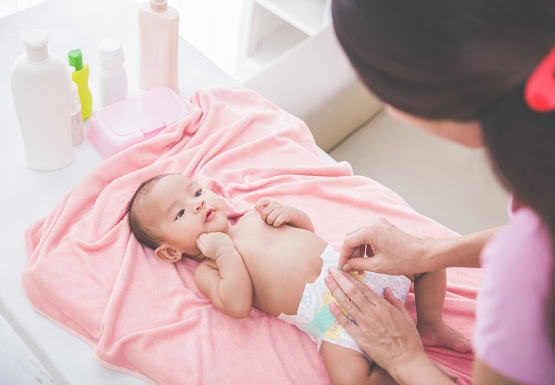Treating Diaper Rash: Prevention is a Better Cure

As parents, there is nothing that compels us to act more than when our little ones are unwell. Despite all the care we put into raising our babies and toddlers, we are visited by a common upset every so often: diaper rashes. The good news is that treatment through prevention is well within a parent’s reach.
WHAT ARE DIAPER RASHES?
Studies show that babies are likely to get a diaper rash at least once in the first 3 years of life, especially when they are between the ages of 9 and 12 months. Diaper rash – or diaper dermatitis – commonly appears as a patchwork of inflamed skin on your baby’s bottom.
The affected skin is usually bright red and is often swollen and irritated. In the most severe cases, the affected area could become infected and develop into blisters, pus-filled pimples, oozing yellow patches or open sores. The first step to treating diaper rash is to understand how it occurs.
WHAT ARE THE KEY CAUSES
Diaper rash can be common when there is a shift in your child’s diet and especially when he/she begins consuming solid foods, resulting in fluctuations of the acidity levels of his/her bowels. The introduction of new food items, such as citrus fruits, into a child’s diet, will change the composition of stools and can increase the frequency of bowel movements.
Outbreaks of diaper rash primarily result from the wetness and moisture that occurs when urine mixes with bacteria in stools and breaks down to form ammonia, an acidic compound that is harsh on the skin. A damp diaper can cause chafing if unchanged, while sustained friction between the diaper and a baby’s bottom damages the delicate outer layer of skin which leads to diaper rash.
This effect is worsened by diapers and clothes which are excessively snug. If your baby has sensitive skin, they might react to chemicals such as those in fragrances used in disposable diapers or detergents used to wash cloth diapers.
Conditions inside the diaper are ideal for the growth of bacteria and yeast, which can also cause diaper rash to emerge in the folds of the skin.
HOW CAN DIAPER RASH BE PREVENTED?
Diaper rash is a fairly common problem for babies, but thankfully, there are tried-and-tested preventive measures you can take to reduce the chances and frequency of your child developing a diaper rash. Doctors often recommend using a diaper cream with zinc oxide, which is antiseptic and has anti-inflammatory properties.
Moreover, creams are able to aid in the recovery of damaged tissue, keep moisture locked into skin, improve the synthesis of collagen and formation of new connective tissue, all while preventing bacteria infections. Use of preventive creams at intervals can significantly reduced the risk of diaper rash.
3 SIMPLE STEPS FOR BETTER SKIN CARE
Here is a diaper rash prevention guide made simple. Follow these three steps to avoid irritation and upsets. Remember, a fresh layer of diaper cream should be used with every diaper change.
1)Preparation
When changing a soiled diaper, be sure to thoroughly remove any previously applied layers of cream with wet wipes or a cotton pad soaked with clean water and allow your baby’s skin to air-dry before proceeding. You may also use a hairdryer on the lowest setting to dry your baby’s skin or gently pat dry with a paper towel without rubbing or irritating the surface area.
2)Application
Apply a thick layer of diaper cream on your baby’s bottom and be sure to get in between the folds of the skin near the genital area for maximum protection. Ensure that the layer is sufficiently thick so that the white of the cream is still visible. This layer acts as a barrier between the delicate skin and the diaper, reducing the friction that occurs when the diaper gets wet.
3)Comfort
Be sure the new diaper fits comfortably on your baby’s bottom without wrapping it too tightly. If your baby is recovering from a rash, be sure to wrap the diaper loosely to ensure reduced friction. If rashes occur, it is best to leave the irritated area exposed to air for at least a few hours a day.
This article is taken from our My Alvernia Magazine Issue #30. Click here to read the issue on our website or on Magzter.



